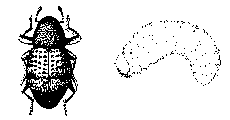Strawberry Crown Borer
Tyloderma fragariae
Biology
Adult crown borers are short-snouted,
reddish-brown, flightless weevils about 1/5-inch long. Their wing covers
are marked with three pairs of darker spots. Adults, which overwinter
in plant debris in strawberry fields or in surrounding areas, become
active in the spring at about the same time that strawberries begin to
bloom. They feed in crowns to open holes into which they lay eggs that
hatch in about one week. Egg-laying continues through mid June.
Yellowish, legless grubs feed for several weeks in strawberry crowns
before pupating in late summer. Adults emerge in the fall, feed on
strawberry foliage, and then seek shelter in plant debris to pass the
winter.

Strawberry corn borer adult and larva.
Adult is about 1/3 inch (8 mm) long;
larva is about 1/4 inch (6 mm) long.
Damage
Although adults eat small holes in leaves in the
fall, this defoliation rarely is economically damaging. Larval feeding
is far more harmful. As one or more larvae bore downward through
strawberry crowns, plants are weakened, stunted, or killed. Field
borders or the portions of fields nearest older, infested plantings are
often most heavily damaged.
Control
Because adult strawberry crown borers cannot fly,
isolating new fields from existing infestations greatly reduces the
likelihood that this insect will cause significant losses. Commercial
growers should use new plants that are free of crown borer and establish
new fields at least 300 yards from existing fields. To prevent crown
borer survival and migration, infested fields should be destroyed and
tilled soon after the final picking. Although chemical control is rarely
advised, some insecticides applied to control other insects may kill
crown borers as well. Prebloom sprays intended to limit damage by
tarnished plant bug kill some crown borer adults, but peak adult
activity occurs slightly later. Egg-laying adults are especially active
during bloom, a time period when insecticides should not be applied.
Insecticides applied between bloom and harvest for the control of
leafroller or sap beetle will also kill crown borer adults if they are
still active on foliage, but killing adults at this time is unlikely to
significantly reduce crown damage. Postharvest sprays may be used to
reduce the population of newly emerged adults in late summer before they
overwinter, but this practice is seldom warranted. Check the latest
edition of the Illinois Commercial Small Fruit and Grape Spray Guide for
a list of registered insecticides.